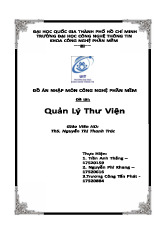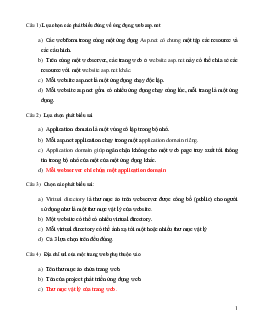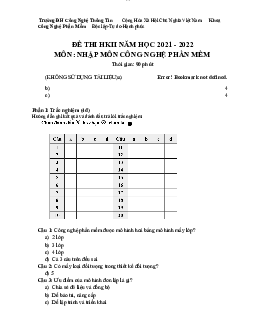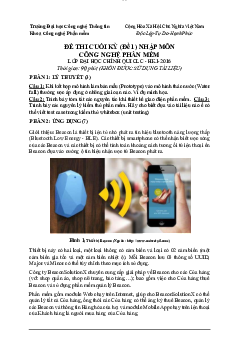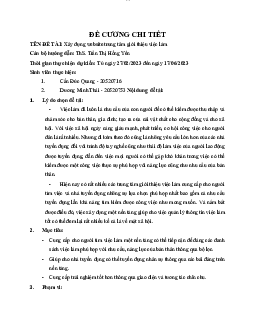



Preview text:
lOMoAR cPSD| 40659592
WaterFall 1/ Definition of the Waterfall model
Waterfall model is a software development model in linear direction, i.e. the development
stages are carried out in a specific sequence, starting from the planning phase, then
design, implement, test and deploy. Each stage must be completed before the next stage begins.
This model is often applied in large-scale software development projects where
requirements are clearly and specifically defined before the development process begins.
However, the Waterfall model also has limitations, such as inflexibility in changing
requirements or incompatibility with highly dynamic software development projects.
2/ WaterFall model definition
The Waterfall model is a linear and sequential software development methodology, where
the development process flows downwards through a series of phases, with each phase
being completed before the next one begins.
The Waterfall model typically consists of the following phases, each of which must be
completed before moving on to the next:
Requirements gathering and analysis: The first phase involves collecting and analyzing
the customer's requirements and developing a detailed understanding of the problem that
the software system will solve.
Design: In this phase, the system's architecture and design are created, taking into
account the requirements identified in the first phase.
Implementation: The actual code is written and the software is developed in this phase.
Testing: In this phase, the software is tested to ensure that it meets the requirements and is free of errors.
Deployment: Once the software has been tested and approved, it is deployed to the customer or end-users.
Maintenance: Finally, the software is maintained, updated, and improved as necessary throughout its lifecycle.
The Waterfall model is often used in industries such as manufacturing and construction,
where a linear, sequential process is required. However, it has been criticized for being
inflexible and not allowing for changes to be made easily once the project has started.
3/ Advantages of the Waterfall model
The Waterfall model has several advantages, including: lOMoAR cPSD| 40659592
Clarity: The Waterfall model is a very structured and well-defined approach to software
development. It offers a clear and easy-to-follow path for the development team, which
can help ensure that everyone is on the same page and working towards the same goal.
Predictability: Because the Waterfall model follows a linear, sequential process, it is
highly predictable. Each phase has clear goals and deliverables, and progress can be easily measured and tracked.
Easy to understand and use: The Waterfall model is easy to understand and use, especially
for smaller projects with well-defined requirements. The simplicity of the model can help
ensure that everyone involved in the project understands what is expected of them.
Documentation: The Waterfall model places a strong emphasis on documentation, which
can help ensure that the software is well-documented and easy to maintain over the long term.
Phased approach: The Waterfall model breaks down the development process into distinct
phases, which can help ensure that each phase is completed thoroughly before moving on
to the next. This can help reduce the likelihood of errors and ensure that the software meets the requirements.
Customer involvement: The Waterfall model requires customer involvement at the
beginning of the project to define requirements, which can help ensure that the software meets the customer's needs.
Overall, the Waterfall model can be a useful approach to software development for
projects with well-defined requirements and a clear understanding of the end goal.
4/ Disadvantages of the Waterfall model
The Waterfall model also has several disadvantages, including:
Inflexibility: The Waterfall model is a linear, sequential process, which means that
changes to the requirements or design can be difficult and expensive to implement once
the project has moved to the later stages of development. This can lead to a lack of
flexibility and adaptability, which can be a significant drawback in today's rapidly
changing business environment.
Limited customer involvement: While the Waterfall model requires customer
involvement at the beginning of the project to define requirements, there is limited
customer involvement during the development process itself. This can result in a lack of
feedback and communication, which can lead to the software not meeting the customer's needs. lOMoAR cPSD| 40659592
Limited testing: The Waterfall model relies on testing at the end of the development
process, which can result in errors and issues being discovered late in the development
cycle. This can be time-consuming and expensive to fix, and can lead to delays in the project timeline.
Documentation overload: While documentation is important in the Waterfall model, it can
also result in documentation overload, where too much time is spent documenting every
aspect of the development process rather than focusing on actually building the software.
Time-consuming: The Waterfall model can be a time-consuming approach to software
development, especially for larger and more complex projects. The linear, sequential
process can result in lengthy development cycles, which can be a significant drawback in
today's fast-paced business environment.
Limited scope for creativity: The Waterfall model relies on a strict and structured
approach to software development, which can limit the scope for creativity and
innovation. This can be a disadvantage in industries where creativity and innovation are key to success.
Overall, the Waterfall model may not be the best fit for all software development projects,
particularly those that require frequent changes or have a high degree of complexity.
5/ When should the WaterFall model be applied?
The Waterfall model can be applied in situations where the following conditions are met:
Well-defined and stable requirements: The Waterfall model is best suited for projects with
well-defined and stable requirements, where the customer's needs are clear and unlikely
to change significantly over the course of the project.
Limited scope for creativity: The Waterfall model may be appropriate in industries where
creativity and innovation are not the primary focus, such as government agencies or large
corporations with established processes and procedures.
Clear project objectives and timeline: The Waterfall model is suitable for projects with
clear objectives and timelines, where the end goal is well-defined and there is a clear path to achieving it.
Limited customer involvement during development: The Waterfall model is appropriate
when the customer's involvement during the development process is limited and
welldefined. If the customer requires frequent feedback and communication, a more
iterative approach such as Agile may be more appropriate. lOMoAR cPSD| 40659592
Structured and organized development process: The Waterfall model is best suited for
projects that require a structured and organized development process, with clearly defined phases and deliverables.
Overall, the Waterfall model may be a good fit for projects with well-defined
requirements, clear objectives and timelines, and limited customer involvement during
the development process. However, it may not be the best fit for all software
development projects, particularly those that require frequent changes or have a high degree of complexity.
